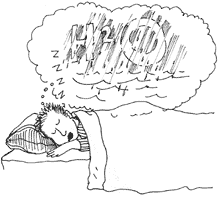Sleep on it: Watery messages come at night

DRAWING BY DEBORAH DERR McCLINTOCK
Q. Tease your brain with this one: What one word does the following sequence represent? H-I-J-K-L-M-N-O. Clue: Think out of the box. Clue 2: A good way to think out of the box is to sleep on a problem. –J. Cousteau
A. That's exactly how a male subject working with sleep researcher William Dement approached it, though not intentionally, says Andrea Rock in The Mind at Night. Before falling asleep, he believed he had solved the problem with the word "alphabet." Then during the night, he had dreams of heavy rain, sailing, and scuba diving– all water dreams. Water? Oh, yeah, water! The liquid familiarly known as H2O. And that unlocked the puzzle.
As Harvard researcher Robert Stickgold has said, in dreams we operate without the anchors of logic and episodic memory, and without the brain chemicals needed for focusing attention. In other words, we brainstorm, thinking outside the box of waking mental limits. And asleep the subject's mind just "wandered" to H2O, or H to O!
Q. Why are so many desert birds black, when everyone knows black absorbs more of the sun's energy than white? –T. E. Lawrence
A. Ornithologists puzzled over this for a long time, until experiments were done actually measuring skin temperatures under white and black plumage, says Pennsylvania State University's Craig Bohren, author of Clouds in a Glass of Beer. Surprisingly, the dark birds had cooler skins! It turns out the incident solar radiation is absorbed in the outer layers of the black plumage, and these layers are insulated from the underlying skin. The white plumage does indeed reflect a fair amount of solar radiation, but much of this is then transmitted to the underlying skin.
To test this out, Bohren placed thermometers in direct sunshine, under either a thin layer of black cloth or a white towel. The black cloths did get hotter on the surface, but the temperature underneath stayed lower by about 0.5 degrees Celsius.
Q. A tourist purchases a car in England and ships it home to the U.S. He loves the car, but finds it getting more like 30 miles per gallon on the open road rather than its sticker-advertised 35 miles per gallon. What's wrong with the vehicle? –M. Gassman
A. It's more the owner's math that could use the tune-up, since he's forgetting that in the United Kingdom a gallon is about 4.5 liters whereas in the U.S. it's about 3.8 liters, say David Halliday et al. in Fundamentals of Physics. Thus for a 900-mile trip in the U.S. the motorist might need approximately 30 gallons of gas compared to only 25.3 gallons purchased in the U.K.
Q. Why does the famous elusive smile of the Mona Lisa, by Leonardo da Vinci, seem at times to change right before your eyes? Is this just in your imagination? –L. Parsons
A. Probably it's more in your eyes, in the nature of human vision, says Harvard neurobiologist Margaret Livingstone in Vision and Art: The Biology of Seeing. Try looking at the painting straight on, with the image falling on your foveas (central retinas), and the smile vanishes. But if you glance more at the background or the hands, the smile seems more apparent and cheerful. This is because the two visions are suited for different tasks: direct foveal vision for picking up fine detail, low- resolution peripheral vision for gathering large chunks of coarse information fast.
And this is part of the mystery: "Mona Lisa smiles until you look at her mouth, and then her smile fades, like a dim star that disappears when you look directly at it."
Send Strange questions to brothers Bill and Rich at .
#